Essential idea: The inheritance of genes follows patterns
Sex-linked inheritance practice problems
Monohybrid inheritance practice problems
Vocabulary
- Genotype: the specific alleles of an organism. (AS, Aa, etc.)
- Phenotype: the observable characteristics or traits of an organism.
- Dominant allele: an allele that has the same effect on the phenotype whether it is present in the homozygous or heterozygous state. Recessive allele: an allele that only has an effect on the phenotype when present in the homozygous state.
- Co-dominant alleles: pairs of alleles that both affect the phenotype when present in a heterozygote.
- Homozygous: having two identical alleles of a gene. (RR or rr)
- Heterozygous: having two different alleles of a gene. (Rr)
- Carrier: an individual that has one copy of a recessive allele that causes a genetic disease in individuals that are homozygous for this allele. (Ex. Sickle cell – AS or Aa)
- Test cross: testing a suspected heterozygote (Rr) by crossing it with a known homozygous (rr) recessive.
Gregor Mendel
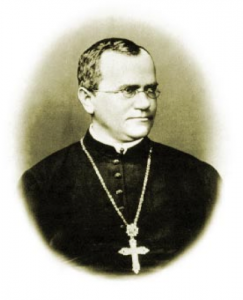
- 1822-1884
- Austrian monk who is known as the “father of genetics”
- Mendel experimented with pea plants and published results on how they passed on their characteristics.
- The term factor was used by Mendel (now we call them genes)
- All his work was completed before DNA and the role it played was established (100 years before)
- Significance of his work was not realized for over 30 years!
Video Questions:
1) What traits did Mendel observe in the pea plants?
Flower color (purple or white), flower position (axil or terminal), stem length (long or short), seed shape (round or wrinkled), seed color (yellow or green), pod shape (inflated or constricted), and pod color (yellow or green)
2) What three important conclusions did Mendel come to when crossing the true breeding white and purple pea flower lines?
–One gene from each parent, purple was dominant, purple is expressed more often, not given more.
3) What laws did Mendel come up with?
–Law of Segregation – Every individual possesses 2 alleles for a trait. Which allele a parent gives its offspring is random.
– Law of Independent assortment – Separate genes are passed independently of each other
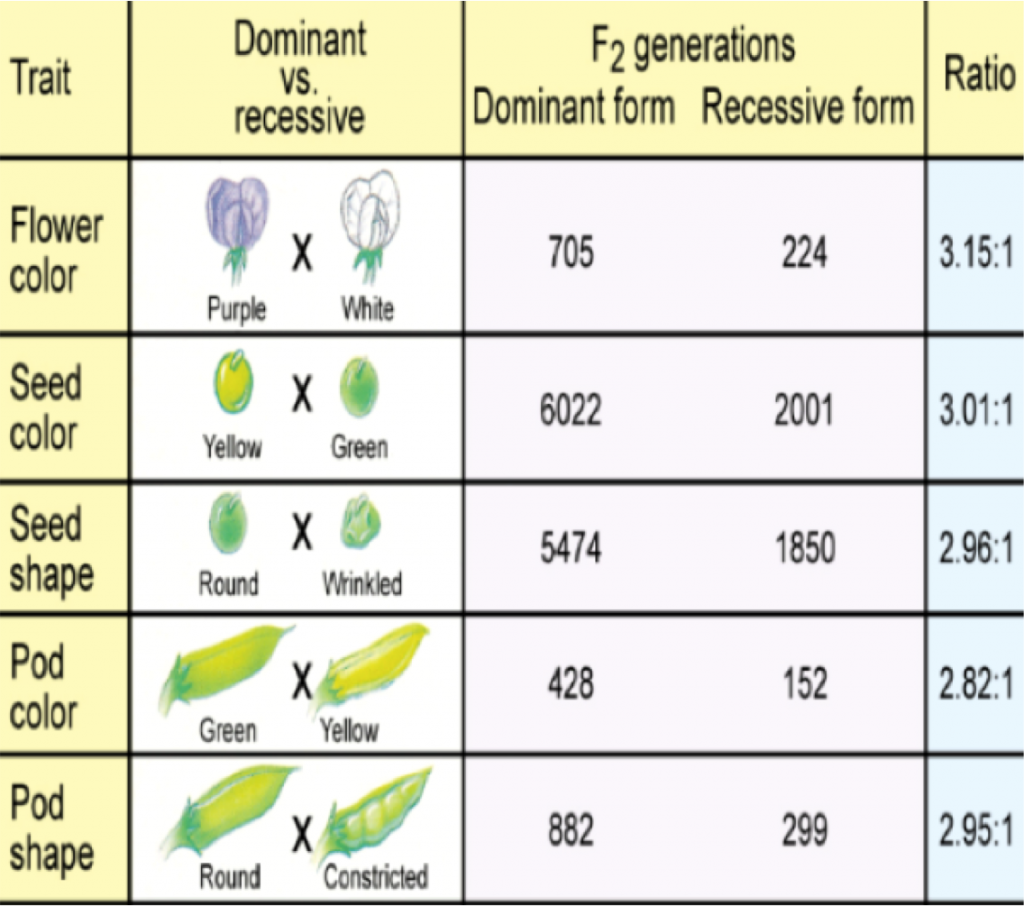
Mendel’s First Law
- Law of Segregation: Alleles of each gene separate into different gametes when the individual produces gametes
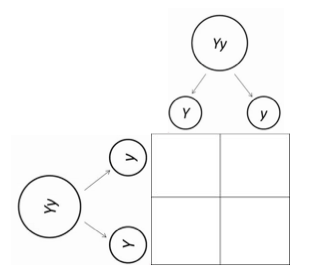
So how did Mendel’s ratios get to be 3:1?

Notice that the F1 generation are all heterozygous for pea flower colour. This is the always the case when crossing true-breeding (homozygous) white flowered plants with true-breeding (homozygous) purple flowered plants (NOTE: This is true for dominant recessive, single-trait alleles)
Crossing two heterozygous individuals produces a phenotypic ratio of 3:1 (purple:white)
Monohybrid Crosses
- A punnett square shows how alleles of parents split between their gametes and how new combinations can show up in the offspring.
- Monohybrid cross – A single trait cross.
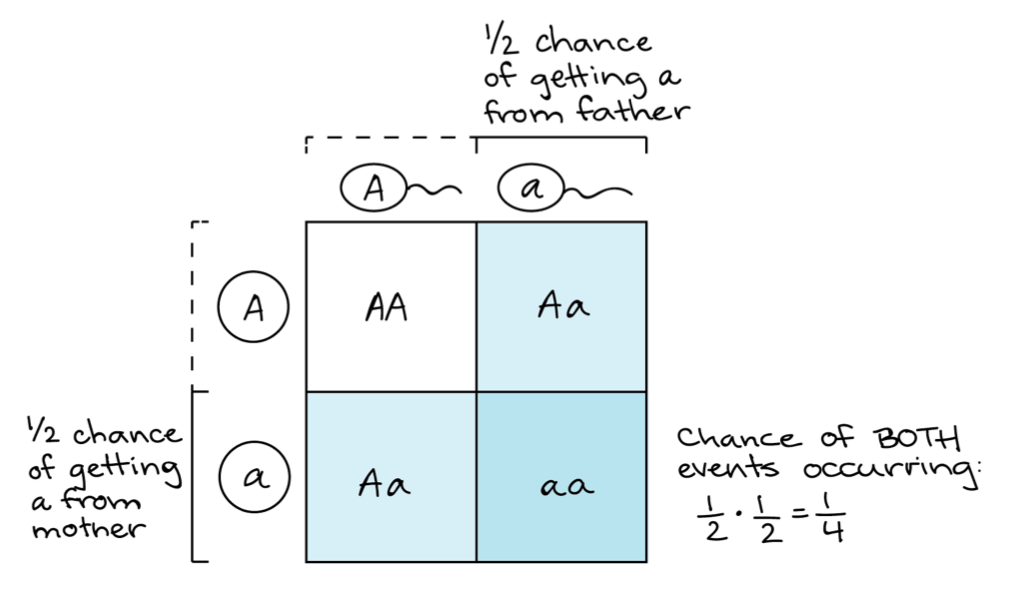
Crafting a punnett square
Five steps:
- Choose a letter to represent alleles (capital letter = dominant, lower case = recessive) Ex. A and a.
- Parents’ genotypes – Three possibilities:
- AA – Homozygous dominant
- Aa – Heterozygous (carrier of recessive allele)
- aa – Homozygous recessive
3. Determine gametes
4) Draw the square – place parental gametes on the top and side of the square.
5) Interpret square
Ex. AA x aa
100% Aa – heterozygous

Mendel’s Second Law
- The Law of Independent Assortment: The presence of an allele of one of the genes in a gamete has no influence over which allele of another gene is present.
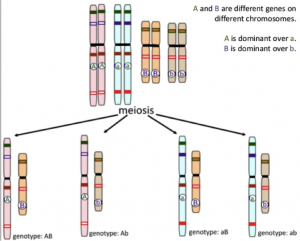
Dihybrid Crosses
” ADihybrid cross is a cross between two different lines (varieties, strains) that differ in two observed traits. In the Mendelian sense, between the alleles of both these loci there is a relationship of complete dominance – recessive.”
- Two traits, each carried of separate chromosomes (Unlinked)
- Ex. Sweet Pea (Lathyrus odoratus)
- Two traits: Pea colour and Pea Surface
- Y- Yellow, y – Green, R – Smooth, r – Rough
Yellow is dominant while green is recessive.
Smooth is dominant while rough is recessive
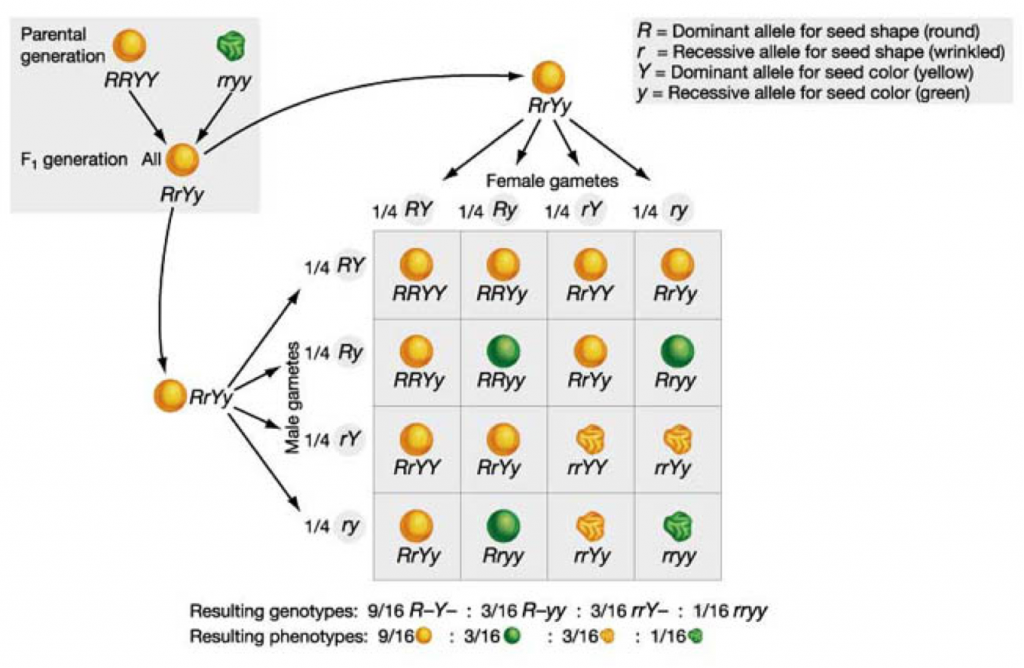
Codominance
- Inheritance characterized by phenotypic expression of both alleles in a heterozygote.
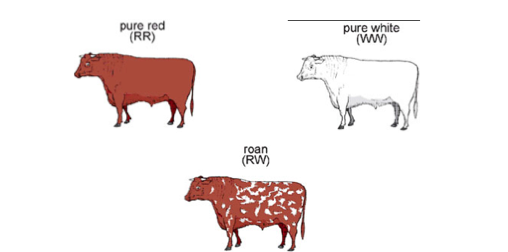
Multiple Alleles
- So far, we have only been considering two possibilities: dominant A and recessive a.
- Two alleles (dom/rec) – three genotypes possible (AA, Aa, aa) and two phenotypes.
- However, in reality their can be three or more alleles for one gene.
- Ex. Blood type in Humans
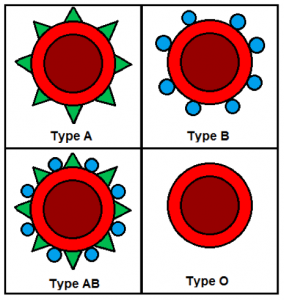
Figure 10: Blood types in human are controlled by 3 alleles – A and B being codominant
In humans, we have three alleles for blood type: A, B, and O.
Proper notation for blood types: (Know this!)
I^A– Produces A type antigens
I^B – Produces B type antigens
i – Produces basic antigens
How many possible phenotypes can be present in humans?
4! A, B, AB, O
- The reason we have 4 possible phenotypes is because IA and IB are co-dominant.
- This means both are expressed in the phenotype equally (i is recessive)
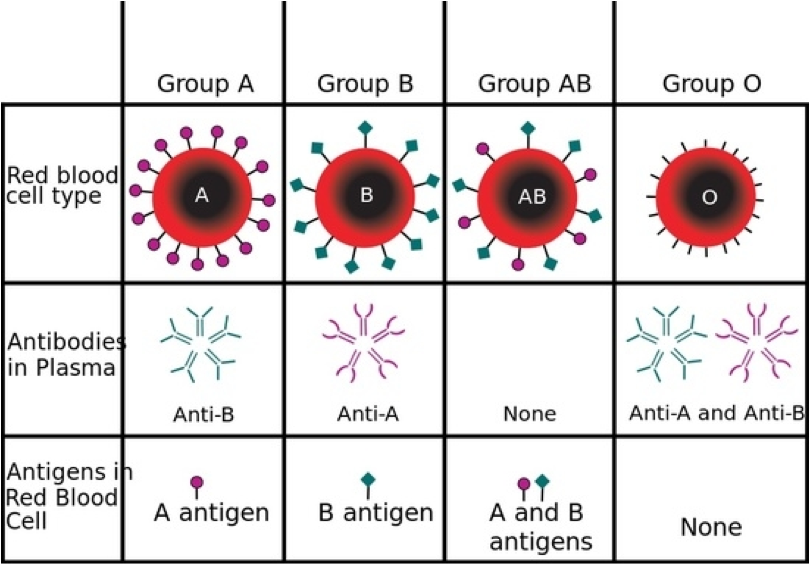

- Antibodies are specific to antigens.
- Immune system recognized “foreign” antigens (such as on RBCs) and produces antibodies in response.
- What would happen if you were given the wrong blood type?
- Blood type O – universal donor (no antigens on RBCs)
- Blood type AB – universal recipient (blood plasma has no antibodies)
Autosomal Genetic Disorders
Autosomal disorders – located on first 22 pairs of chromosomes.
- Cystic Fibrosis is an autosomal recessive disease (It is caused by a recessive allele and the locus of the gene is found on one of the first 22 pairs of chromosomes).
- A mutation in the CFTR gene causes secretions which are usually thin instead to become thick – this leads to blocked passageways and ducts (especially in lungs).
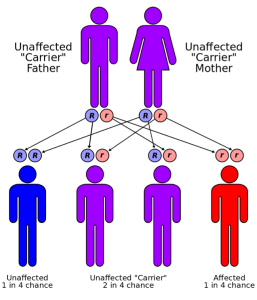
Autosomal recessive inheritance pattern
- Albinism
- CF
- Tay-Sachs disease
- Trimethylaminuria
- Sickle cell disease (co –dominant)
Huntington’s disease is an example of autosomal dominant inheritance.

- Mutation leads to repetition of CAG sequence In the gene.
- This causes the protein Huntingtin (Htt) to clump together and destroy the brain cell.
- Most common is Adult-onset Huntington disease, usually appearing in a person’s thirties or forties.
Recap:
Autosomal recessive inheritance – CF
- Ff x Ff – 3:1 ratio (Normal:CF)
Co-Dominant – SCD
- AS x AS – 1:2:1 ratio (Normal: SCT (Carrier): SCD)
Dominant – Huntington’s disease
- Hh x Hh – 1:1 ratio (Normal:Huntington)
Sex-linked genetic disorders
- Affected gene locus is on the sex chromosomes (typically X)
- The ratios are different in males and females due to this.
- Examples: Red-Green colour blindness, Hemophilia
- Both are recessive sex-linked disorders on the X chromosome.
Question: How would the ratios of affected individuals be different for males/females?
- More common in males because males only have one X chromosome – if they inherit the recessive X chromosome, they have the disorder
- Females have two – they must inherit both recessive X chromosomes – one from each parent.
- Therefore – sex-linked disorders are rare in females.
Example: Crossing a colourblind male Xby with normal female X^BX^B
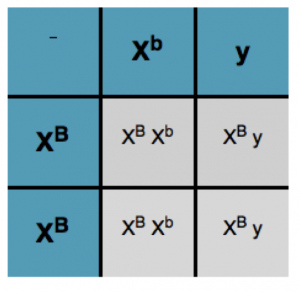
All offspring will be normal – however the females will be carriers.
Pedigree Charts
- Used to trace family histories and deduce genotypes and risk in the case of inherited disorders.
- We can determine patterns of inheritance from pedigree charts

Practice:

- Dominant or Recessive? How do you know?
- Autosomal or Sex-linked? How do you know?
1. Dominant – A&B Produced unaffected offspring – if it were recessive, this could not happen. Parents must be heterozygous.
2. Autosomal – Male C can only pass on Y chromosome – if it were X dominant, daughter H would have it as well.
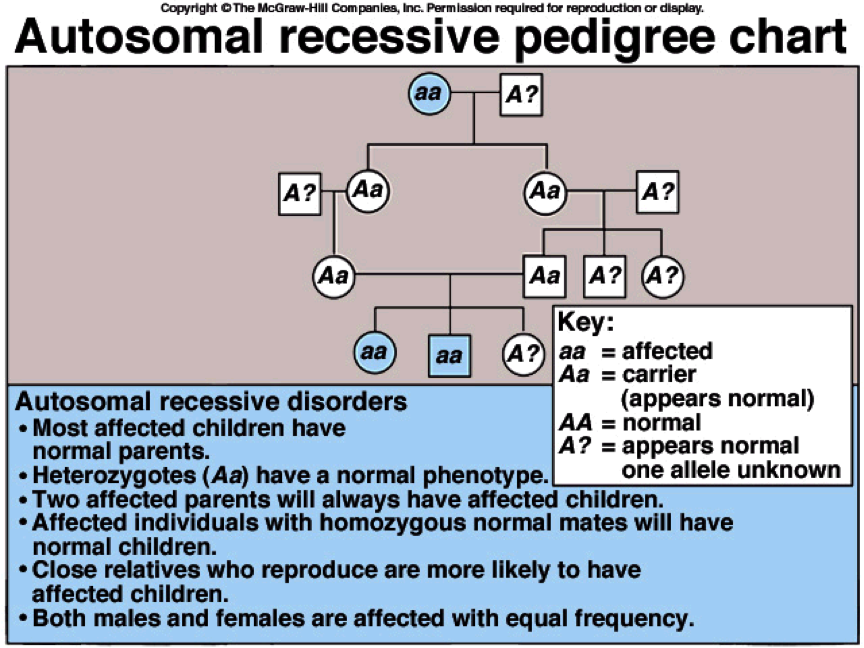
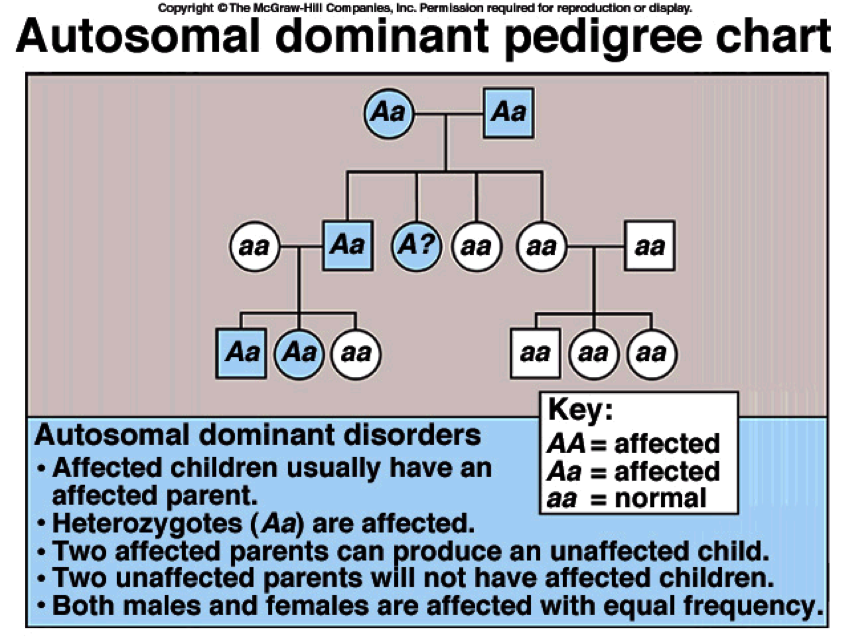
Radiation and Mutation Rate
- A mutation is a random change to the base sequence of a gene
- Both radiation and certain chemicals can cause genetic diseases and cancer. These are consider to be mutagenic.
- Radiation can cause mutations if it has enough energy to chemical change one’s DNA.
Ex. Gamma rays, UV radiation and x-rays
- Certain chemical substances can all cause chemical change in DNA and are therefore considered mutagenic.
- Ex. Benzene (industrial solvent and precursor in the production of drugs, plastics, synthetic rubber and dye), and Nitrosamines (an important group of mutagens found in tobacco).
- Mutations can occur in the gametes, leading to inherited genetic disorders.
Nuclear bombings of Hiroshima and Nagasaki
Two bombs were dropped on Hiroshima and Nagasaki in August 1945 – signaling the end of World War II.
The bombs were detonated above ground, dispersing the radiation.
Long Term Consequences:
- Elevated rate of Leukemia
- Elevated rate of other cancers
- No significant increase in mutations or birth defects in offspring of those affect.
Chernobyl Disaster
- A nuclear meltdown in Priypat, Ukraine (1986)
- One of only two nuclear energy accidents classified as level 7 – the other being the Fukushima Daiichi nuclear disaster.
- Long term effects:
- Large forest down wind died, along with horses and cattle near the plant (thyroid damage)
- Drinking water contaminated with radioactive iodine leading to thyroid cancer.
- 250% increase in birth defects following the meltdown.
Comments by shaun pletsch